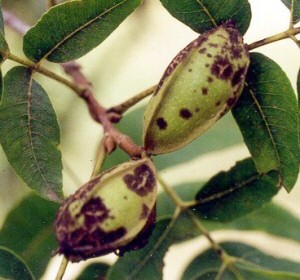Scab on Pecan
 Causal Agent
Causal Agent
The fungus, Cladosporium caryigenum (formerly Fusicladium effusum).
Hosts
Pecans.
Symptoms
 The disease is characterized by small, dark, circular, olive to black spots on foliage
and nuts. These spots may fuse to form large blackened areas. If the disease is not
controlled, entire crops from most cultivars (varieties) and some native and seedling
trees may be lost during periods of frequent rains or extended dew. The pink mold
fungus, Cephalothecium roseum, invades old scab lesions on nut shucks. If it invades
the nut kernel, it can cause off flavors and pink rot. The shells of infected nuts
may have an oily appearance.
The disease is characterized by small, dark, circular, olive to black spots on foliage
and nuts. These spots may fuse to form large blackened areas. If the disease is not
controlled, entire crops from most cultivars (varieties) and some native and seedling
trees may be lost during periods of frequent rains or extended dew. The pink mold
fungus, Cephalothecium roseum, invades old scab lesions on nut shucks. If it invades
the nut kernel, it can cause off flavors and pink rot. The shells of infected nuts
may have an oily appearance.
Control
Pecan scab is readily controlled with properly applied sprays of effective recommended fungicides, in conjunction with strict adherence to recommended sanitary practices, or by use of resistant cultivars.
When starting a new orchard, it is advisable to plant tolerant or resistant cultivars (varieties) such as Chickasaw, Choctaw, Gormley, Graking, Mohawk, Mount, Oakla, Stuart, and Peruque. Cultivars which should not be planted in much of the state, unless on is prepared to follow a scab control program, include Apachee, Burkett, Caddo, Cherokee, Cheyenne, Cowley, Desirable, Green River, Hayes, Mahan, Maramec, San Saba Improved, Schley, Shawnee, Shoshoni, Sioux, Squirrel, Tejas, Western, and Wichita. For detailed information on pecan cultivars, see OSU Extension Facts No. 6201, "Pecan Varieties for Oklahoma". Please contact your local county extension office for current information.
